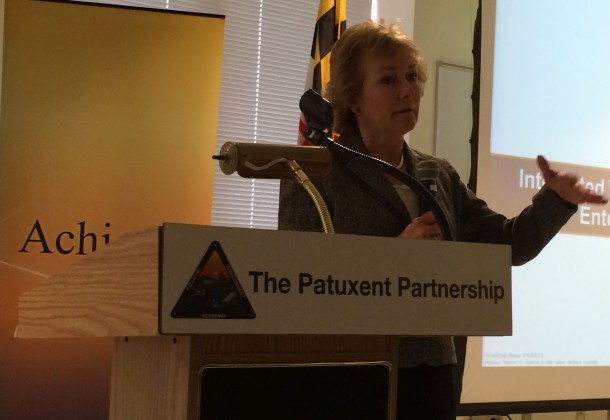Open Architecture vs Proprietary Property

It was a lot of information and a lot of dense slides accompanying two intense presentations about Integrated Warfighting Capabilities, from NAVAIR to mostly a defense industry audience. But one challenge was very clear, Open Architecture vs Proprietary Property.
It is difficult and complicated, but Integrated Warfighting Capabilities will occur, said two of NAVAIR’s top implementers: Leslie Taylor, SES, Executive Director, Integration and Interoperability / Integrated Warfighting Capability Enterprise Team Lead, Naval Air Systems Command and RDML(sel) Shane G. Gahagan, Military Director, Integrated Warfare Capability Enterprise Team, Naval Air Systems Command.
Simplified, most parts on most aircraft are unique to that specific aircraft. This is the same across the military and its respective vehicles, vessels, warfighting platforms of all kinds. It would be cheaper and more efficient if the maximum number of parts were interchangeable.
This is very clear to NAVAIR, which is sustaining a mission to see that integration of systems between platforms occurs. It will require increasing use of open architecture. To do that quickly, requires NAVAIR to “acquire in different ways,” RDML Gahagan told about 100, mostly defense contractors, attendees at The Patuxent Partnership’s IWC briefing last week. And there’s the rub.
Talking fast and running through a powerful set of slides, RDML Gahagan made visible the threats and stakes of the world’s vast waterways which cover 70 percent of the globe. These are the Navy’s responsibility to keep safe from hostile forces and to keep open the world’s free trade routes. To stress budgetary and strategic necessities of interoperability of all Naval machinery was hardly necessary. Global threats are rising and the Navy is shrinking. The budget changes, said RDML Gahagan, but the Pacific mission doesn’t.
Integration of systems between platforms and increased use of open architecture, to a defense contracting firm, is tantamount to giving away millions of dollars of development investment and proprietary claim upon future developments. Proprietary property makes up much of the underpinnings of the defense industry. Proprietary concerns are further complicated by stringent security requirements.
Questions from the audience circled largely around the difficulties with acquisition, proprietary properties, and security. The difficulties were acknowledged and addressed by both presenters.
RDML Gahagan described setting standards for sharing early, classified knowledge between prime contractors as “very hard.”
Ms. Taylor said as difficult as it will be for the “primes,” it will likely be more difficult for small businesses. “We don’t have all those answers yet.” Standards have been set, she explained, which is helping the transition, but “standards can be reached differently” and that start-to-finish process needs to be standardized as well.
Nevertheless, Ms. Taylor emphasized the determination of NAVAIR to adopt interoperability and in a way that will be accessible across systems commands. Though progress toward a fully integrated warfighting capability is not even, progress is obvious across the Navy and in other services as well. This is the third year NAVAIR has prioritized this change mission, propelled by two successive admirals committed to upgrading to integrated, open architecture as quickly as possible.
Although acknowledging the process could be arduous, both presenters emphasized that the task before them was not to cut out industry, but to make the integration work for both contractors and military.
“The ideas,” said RDML Gahagan, gesturing to the audience, “are in industry.”























